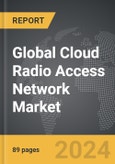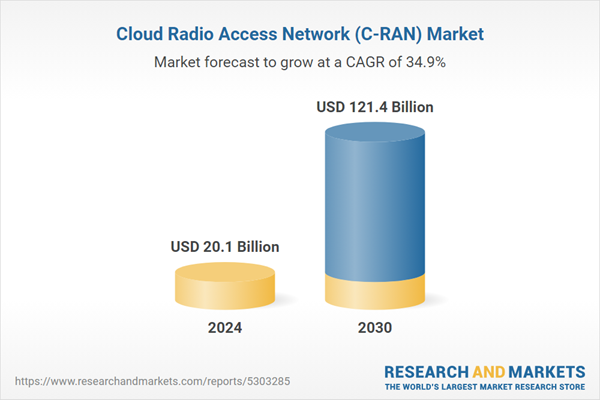The global market for Cloud Radio Access Network (C-RAN) was valued at US$20.1 Billion in 2024 and is projected to reach US$121.4 Billion by 2030, growing at a CAGR of 34.9% from 2024 to 2030. This comprehensive report provides an in-depth analysis of market trends, drivers, and forecasts, helping you make informed business decisions. The report includes the most recent global tariff developments and how they impact the Cloud Radio Access Network (C-RAN) market.
Segments: Component (Services, Solutions); Deployment (Cloud, Centralized); End-Use (Telecom Operators, Enterprises).
Geographic Regions/Countries: World; United States; Canada; Japan; China; Europe (France; Germany; Italy; United Kingdom; and Rest of Europe); Asia-Pacific; Rest of World.
The analysts continuously track trade developments worldwide, drawing insights from leading global economists and over 200 industry and policy institutions, including think tanks, trade organizations, and national economic advisory bodies. This intelligence is integrated into forecasting models to provide timely, data-driven analysis of emerging risks and opportunities.
Global Cloud Radio Access Network (C-RAN) Market - Key Trends & Drivers Summarized
Why Is Cloud RAN Transforming the Telecom Industry?
Cloud Radio Access Network (C-RAN) is revolutionizing the telecom industry by addressing the increasing demand for high-speed connectivity, low latency, and cost-efficient network operations. C-RAN centralizes the processing of radio access functions in the cloud, enabling telecom operators to replace traditional, hardware-heavy base stations with more agile and scalable cloud-based solutions. This architecture enhances network flexibility, allowing operators to scale resources based on real-time demand and optimize their spectrum usage. For telecom providers, C-RAN offers a cost-effective approach to managing growing data demands, particularly in dense urban areas where mobile data usage is high and network capacity is frequently strained. As 5G deployment accelerates, C-RAN is proving essential for meeting the low-latency and high-bandwidth requirements of next-generation applications, such as IoT, autonomous vehicles, and augmented reality. The ability of C-RAN to support these demanding applications while optimizing operational efficiency and resource utilization is driving its adoption across telecom networks globally, positioning it as a key enabler of future connectivity.How Are Technological Advancements Enhancing C-RAN Capabilities?
Advancements in virtualization, edge computing, and artificial intelligence are significantly enhancing the functionality and efficiency of C-RAN solutions. Virtualization allows telecom operators to separate hardware and software functions, creating a flexible and dynamic network architecture that can be scaled and managed remotely. This virtualized infrastructure supports Network Function Virtualization (NFV) and Software-Defined Networking (SDN), enabling centralized management and reducing the cost and complexity of network upgrades. Edge computing brings processing power closer to the user, reducing latency and enhancing the performance of applications that require real-time data processing. By integrating AI and machine learning, telecom operators can use predictive analytics to manage traffic loads, optimize network resources, and improve the quality of service (QoS) based on data-driven insights. These technologies collectively enhance the scalability, performance, and operational efficiency of C-RAN systems, making them better equipped to handle the challenges of 5G and beyond, while offering a responsive, adaptive network that aligns with the evolving demands of digital services.Which Industries Stand to Benefit from C-RAN Adoption Beyond Telecommunications?
While telecommunications remains the primary industry driving the demand for C-RAN, other sectors are beginning to adopt this technology to meet their connectivity needs. The automotive industry, for example, relies on robust and low-latency networks to enable connected and autonomous vehicles, which require constant, high-speed data communication for navigation, traffic management, and safety. The manufacturing sector, embracing Industry 4.0, benefits from C-RAN by supporting IoT-enabled factories with reliable connectivity for smart machines, robotics, and real-time data analytics. Additionally, the healthcare industry, which increasingly uses telemedicine, remote diagnostics, and mobile health applications, can leverage C-RAN to support high-speed, low-latency communication between devices and care providers, enhancing patient care and operational efficiency. C-RAN is also valuable in smart city projects, enabling city-wide connectivity for applications like traffic management, energy optimization, and public safety. The ability of C-RAN to support diverse, data-intensive applications makes it an attractive solution for a wide range of industries looking to harness the power of real-time connectivity.What’s Driving Growth in the Cloud RAN Market?
The growth in the Cloud RAN market is driven by several factors, including the rapid deployment of 5G networks, the need for cost-effective network scalability, and increasing demand for low-latency applications. The global rollout of 5G has significantly accelerated demand for C-RAN, as its centralized architecture is better suited to handle the high bandwidth, ultra-low latency, and massive device connectivity requirements of 5G applications. Cost savings are another major driver, as C-RAN reduces capital and operational expenditures by allowing telecom operators to share network resources and simplify infrastructure management. The growing need for low-latency communication to support applications in autonomous vehicles, virtual reality, and IoT has further fueled the adoption of C-RAN, as it provides the reliable and responsive network needed for real-time data processing. Additionally, advancements in virtualization, AI, and edge computing have made C-RAN systems more efficient and adaptable, enabling telecom providers to offer better service while managing network traffic more dynamically. These factors underscore the strong growth trajectory of the C-RAN market, as telecom providers and other industries invest in scalable, flexible network architectures to meet the demands of modern connectivity.Report Scope
The report analyzes the Cloud Radio Access Network (C-RAN) market, presented in terms of units. The analysis covers the key segments and geographic regions outlined below.Segments: Component (Services, Solutions); Deployment (Cloud, Centralized); End-Use (Telecom Operators, Enterprises).
Geographic Regions/Countries: World; United States; Canada; Japan; China; Europe (France; Germany; Italy; United Kingdom; and Rest of Europe); Asia-Pacific; Rest of World.
Key Insights:
- Market Growth: Understand the significant growth trajectory of the Services segment, which is expected to reach US$76.9 Billion by 2030 with a CAGR of a 33.9%. The Solutions segment is also set to grow at 36.8% CAGR over the analysis period.
- Regional Analysis: Gain insights into the U.S. market, valued at $6.1 Billion in 2024, and China, forecasted to grow at an impressive 33.2% CAGR to reach $17.6 Billion by 2030. Discover growth trends in other key regions, including Japan, Canada, Germany, and the Asia-Pacific.
Why You Should Buy This Report:
- Detailed Market Analysis: Access a thorough analysis of the Global Cloud Radio Access Network (C-RAN) Market, covering all major geographic regions and market segments.
- Competitive Insights: Get an overview of the competitive landscape, including the market presence of major players across different geographies.
- Future Trends and Drivers: Understand the key trends and drivers shaping the future of the Global Cloud Radio Access Network (C-RAN) Market.
- Actionable Insights: Benefit from actionable insights that can help you identify new revenue opportunities and make strategic business decisions.
Key Questions Answered:
- How is the Global Cloud Radio Access Network (C-RAN) Market expected to evolve by 2030?
- What are the main drivers and restraints affecting the market?
- Which market segments will grow the most over the forecast period?
- How will market shares for different regions and segments change by 2030?
- Who are the leading players in the market, and what are their prospects?
Report Features:
- Comprehensive Market Data: Independent analysis of annual sales and market forecasts in US$ Million from 2024 to 2030.
- In-Depth Regional Analysis: Detailed insights into key markets, including the U.S., China, Japan, Canada, Europe, Asia-Pacific, Latin America, Middle East, and Africa.
- Company Profiles: Coverage of players such as Altiostar, Asocs Ltd., Cisco Systems, Inc., Ericsson AB, Fujitsu and more.
- Complimentary Updates: Receive free report updates for one year to keep you informed of the latest market developments.
Some of the 34 companies featured in this Cloud Radio Access Network (C-RAN) market report include:
- Altiostar
- Asocs Ltd.
- Cisco Systems, Inc.
- Ericsson AB
- Fujitsu
- Huawei Technologies Co., Ltd.
- Intel Corporation
- Mavenir Systems
- NEC Corporation
- Nokia Corporation
- Samsung Electronics Co Ltd
- ZTE Corporation
Tariff Impact Analysis: Key Insights for 2025
Global tariff negotiations across 180+ countries are reshaping supply chains, costs, and competitiveness. This report reflects the latest developments as of April 2025 and incorporates forward-looking insights into the market outlook.The analysts continuously track trade developments worldwide, drawing insights from leading global economists and over 200 industry and policy institutions, including think tanks, trade organizations, and national economic advisory bodies. This intelligence is integrated into forecasting models to provide timely, data-driven analysis of emerging risks and opportunities.
What’s Included in This Edition:
- Tariff-adjusted market forecasts by region and segment
- Analysis of cost and supply chain implications by sourcing and trade exposure
- Strategic insights into geographic shifts
Buyers receive a free July 2025 update with:
- Finalized tariff impacts and new trade agreement effects
- Updated projections reflecting global sourcing and cost shifts
- Expanded country-specific coverage across the industry
Table of Contents
I. METHODOLOGYII. EXECUTIVE SUMMARY2. FOCUS ON SELECT PLAYERSIII. MARKET ANALYSISREST OF WORLDIV. COMPETITION
1. MARKET OVERVIEW
3. MARKET TRENDS & DRIVERS
4. GLOBAL MARKET PERSPECTIVE
UNITED STATES
CANADA
JAPAN
CHINA
EUROPE
FRANCE
GERMANY
ITALY
UNITED KINGDOM
REST OF EUROPE
ASIA-PACIFIC
Companies Mentioned (Partial List)
A selection of companies mentioned in this report includes, but is not limited to:
- Altiostar
- Asocs Ltd.
- Cisco Systems, Inc.
- Ericsson AB
- Fujitsu
- Huawei Technologies Co., Ltd.
- Intel Corporation
- Mavenir Systems
- NEC Corporation
- Nokia Corporation
- Samsung Electronics Co Ltd
- ZTE Corporation
Table Information
| Report Attribute | Details |
|---|---|
| No. of Pages | 89 |
| Published | April 2025 |
| Forecast Period | 2024 - 2030 |
| Estimated Market Value ( USD | $ 20.1 Billion |
| Forecasted Market Value ( USD | $ 121.4 Billion |
| Compound Annual Growth Rate | 34.9% |
| Regions Covered | Global |









